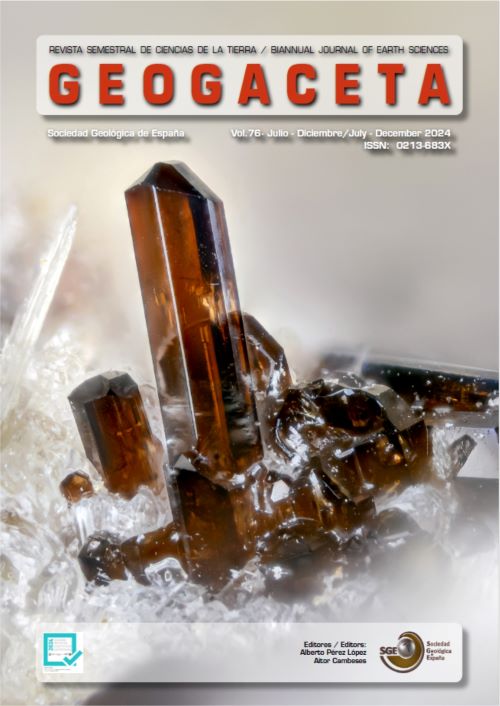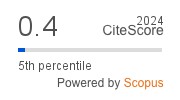Tectónica activa en formaciones marinas cuaternarias en la región de Tánger (Noroeste de Marruecos): Contribución de la técnica PSInSAR
DOI:
https://doi.org/10.55407/geogaceta104565Palabras clave:
Costa Atlántica, neotectónica, Cuaternario, Tánger, PSINSARResumen
Este estudio investiga la actividad tectónica reciente en Tánger, Marruecos, utilizando datos de PSInSAR y observaciones de campo microtectónicas. La exploración de depósitos marinos en la cuenca de Ashokan durante el período Plio-Cuaternario tiene importancia para rastrear los cambios geodinámicos recientes en el área de estudio. El análisis microtectónico reveló un cambio de un régimen de compresión NE-SO en el Plioceno tardío a un régimen cuaternario dominado por un régimen de extensión NE-SO y un régimen de compresión NW-SE. PSInSAR detectó tasas de desplazamiento del suelo que oscilaron entre hundimiento (-4,9 mm/año) y levantamiento (4,9 mm/año) durante el período de estudio (2018-2021).
Citas
Aboumaria, K., Zaghloul, M.N., Battaglia, M., Loiacono, F., Puglisi, D., Aberkan, M. (2009). Journal of African Earth Sciences 55, 10-35. https://doi.org/10.1016/j.jafrearsci.2008.12.004
Ait Brahim, L., (1991). Brittle tectonics and recent stress states in Northern Morocco. Results from the kinematics of the Africa - Europe plates and the Alboran block. State Thesis, Mohamed V University, Rabat, 244p.
Akil, M., Chalouan, A., Istiquam, H., El Fahssi, A., Mamad, A. (1995). Les formations quaternaires de la Rive Sud du Detroit de Gibraltar: Stratigraphie et déformation. El Enlace Fijo del Estrecho de Gibraltar 2. 71-79.
Alouane, M., (1996). Géologie Méditerranéenne 23, n34, 187-199. https://doi.org/10.3406/geolm.1996.1589
Boccaletti, M., Conedera, C., Dainelli, P. (1985). Tectonic map of the Western Mediterranean area. Scale 1:2.500.000.
Cadet, J.P., Fourniguet, J., Gigout, M., Guillemin, M. and Pierre, G., (1977). Bulletin of the Geological Society of France, (7), 19, n3, 600 - 605. https://doi.org/10.2113/gssgfbull.S7-XIX.3.600
Crosetto, M., Monserrat, O., Devanthéry, N., Cuevas-González, M., Barra, A., Crippa, B. (2016). Int. Arch. Photogramm. Remote Sens. Spatial Inf. Sci. XLI-B7, 835-839. https://doi.org/10.5194/isprs-archives-XLI-B7-835-2016
Delgado Blasco, J.M., Foumelis, M. (2018). Automated snap sentinel-1 DInSAR processing for StaMPS PSI with open-source tools. https://zenodo.org/records/1322353 (may, 2024).
Delvaux, Damien (2012). Geophysical research abstracts. Vol 14. No. 2. EGU General Assembly Vienna
Díaz García, F. (1993). Revista de la Sociedad Geológica de España 6, 105-114.
Foumelis, M., Delgado Blasco, J.M., Desnos, Y.-L., Engdahl, M., Fernandez, D., Veci, L., Lu, J., Wong, C. (2018). IEEE International Geoscience and Remote Sensing Symposium, Valencia, 1364-1367. https://doi.org/gfwvdq
Guillemin, M., Houzay, J.P., (1982). Notes Mémoires du Service Géologique du Maroc, 314, 7 pp
Hooper, Andy, et al. (2010). "StaMPS/MTI manual". Delft University of Technology, The Netherlands, 26 p.
Istiquam, H., (1999). Alpine tectonics, neotectonics, and study of Quaternary marine formations on the southern shore of the Strait of Gibraltar (Tangier - Charf-Al-Akab sector). D.E.S. (Diplôme d'Études Supérieures) Thesis, Mohammed V University, Rabat, 253 p.
Khalid Lakhouidsi, Abdelali Fadil, Abdelilah Tahayt, and Abderrahmane Soulaimani (2024). Canadian Journal of Earth Sciences, 61, 586-596. https://doi.org/10.1139/cjes-2023-0104
Leblanc, D. (1979). Etude géologique dans Le Rif Externe Oriental au Nord de Taza (Maroc).
Morel, J.L., Meghraoui, M. (1996). Geology 24, 755-758. https://doi.org/dfqd94
Morel, J.L., (1988). Recent evolution of the Rif orogeny and its foreland since the end of nappe emplacement. Mémoires de Géodiffusion, Paris, 4, 584 p.
Suter, G. (1980). Carte géologique de la chaîne rifaine 1/500 000. Notes et mém, serv. Géol. Maroc, 245a.
Tichli, S., Outiskt, M., Bernoussi, A.S., Aboumaria, K. (2024). Journal of African Earth Sciences 209, 105120. https://doi.org/10.1016/j.jafrearsci.2023.105120
Wildi, W. (1983). Revue de géographie physique et de géologie dynamique, 24(3) 201-297.
Descargas
Publicado
Cómo citar
Número
Sección
Licencia
Derechos de autor 2024 Rida Haddane, Khadija Aboumaria, Afaf Amine, Mohamed Saadi, Soukaina Mouljebouj, Saida Niazi

Esta obra está bajo una licencia internacional Creative Commons Atribución-NoComercial-CompartirIgual 4.0.
Hasta el año 2023 el autor/a cedía el copyright (“derechos de autor”) a la Sociedad Geológica de España, pero desde el 2024 el/la autor/a conserva los derechos de autor y concede a la Sociedad Geológica de España el derecho de la primera publicación y de manera no exclusiva cede la distribución de cada artículo en todos los soportes actuales o futuros, al mismo tiempo que ceden, también de manera no exclusiva, los derechos comerciales para la distribución de la versión impresa de Geogaceta. Por otra parte, los artículos, a partir del año 2023, están disponibles simultáneamente a su publicación, bajo la licencia Creative Commons CC BY-NC-SA 4.0, que permite copiar, transformar el trabajo, pero si se distribuye transformándolo, el nuevo trabajo debe distribuirse bajo la misma licencia, y nunca con propósitos comerciales, al tiempo que se reconoce la autoría y la publicación original en GEOGACETA, de tal manera que el único rol del copyright es dar a los autores el control sobre la integridad de sus trabajos y el derecho de ser adecuadamente reconocidos y citados.









